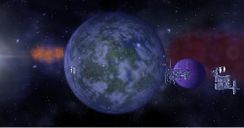Planet New Paris
This article has not been verified to be up to date for the latest version of the Discovery mod. The last edit was made on 12.02.2015 (DD/MM/YYYY). You may help by updating it, often by using the code generator.
| Planet New Paris | |
| Location | 6E, Ile-de-France |
| Technical information | |
| Docking | No |
| Terrain | Terrestrial |
| Diameter | 12,418 km |
| Mass | 5.95 x 10e24 kg |
| Temperature | -66°C to 68°C |
| Escape velocity | 11.28 km/sec |
New Paris was the first planet colonized by the Gallic Sleeper Ship's arrival in 84 A.S. (0 A.G.S.). Biologically, the world is similar to Earth of the Carboniferous period (late Paleozoa). It has vast forests in equatorial and moderate regions but only a few large animal species capable of breathing atmospheric oxygen. Oxygen concentration on New Paris is similar to human-inhabited Earth, being about 24 percent (unlike true Carboniferous on Earth when the concentration was almost twice as high). This did not allow large insect species to develop, leaving more room for smaller amphibious tetrapods and predecessors of birds. Colder continental areas were scarcely inhabited and had no large flora. Oceanic wildlife is extremely rich with a wide variety of species, most of them not bearing any similarity with any known Earth animals. The planet's climate was more or less similar to Earth, with temperatures as high as 60°C in equatorial regions, and frequently dropping below -60°C in polar regions.
New Paris has undergone several periods of development, starting with isolated colonies that had highly reproductive populations. Very soon afterwards, large cities emerged from those settlements, and food demand forced them to exploit huge amounts of land to plant crops and raise animals brought from Earth. In many areas, indigenous wildlife was fully replaced with domesticated animals and plants originating from Earth, and accompanying species. Rapid industrial growth resulted in severe pollution that still affects certain areas of the planet, but was mostly cleared out in subsequent centuries. In about 200 A.G.S., the population of the planet was nearing 5 million, and huge urbanization centers emerged in moderate climate areas near convenient harbors. Those centers were named after old Paris districts, and three of them (Ile du Palais, Saint-Germain and Saint-Denis) have their own orbital docking rings.
The population grew steadily and reached 1 billion by 600 A.G.S. . Millions of people relocated off-world, with massive relocation campaigns taking place to populate worlds with huge resource deposits and industrial capacity, like Amiens (Provence), Bourges (Berry) and later Marne (Champagne). Apart from the relocation programs, many people left New Paris to find cheaper places to live and "new beginnings" for themselves, since New Paris gradually became the most expensive place to live in all of Gallia, except for resort planets, and Marseille in particular. Remote worlds with less comfortable climate provided (and still provide) far lower land and property costs. Ecology issues forced the removal of heavy industry away from New Paris to space stations in Ile-de-France and beyond. The few remaining old-style factories now serve as museums where citizens can observe impressive industrial landmarks similar to those seen on XXII century Earth. Currently, the planet with its 16.3 billion population is considered to be one of the most comfortable places to live in all of Gallia. The planet also never lost its status as the capital of the House of Gallia. Offices of the Royal Government and Royal Chancery, as well as the High Courts and the Parliament, are located within the largest urban centers of New Paris. The monarch with his or her court usually inhabits one of the numerous summer or winter Royal residences.
